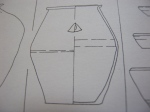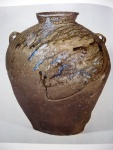So, what is Nanban. The word is interesting in Japanese. It has two characters, 南蛮 The first means south or southern and the second one means unrefined. Taken together they mean Southern barbarians or if combined with a noun mean Western …. An example would be the combination 南蛮渡来の品 which means items brought in from Indonesia, Phillippines and Thailand. This combination dates from the Muromachi and Edo period but is still used today for antiques that are from that period and originate from those areas. Another example is 南蛮画、the last character means picture in this combination. This word has two meanings. Paintings brought into Japan from the West during the latter part of the sixteenth century. The second meaning is Japanese painters that painted in a Western style in the Edo period. One last example is 南蛮人 which means Westerners, in particular Spaniards and Portuguese. The important part of the meaning to remember is its original meaning of unrefined. I have seen some dictionaries define the base word Nanban as “wild red-haired barbarians”. It isn’t hard to imagine the Dutch being blessed with that definition back in the day. Just a couple of notes on words for non-Japanese. The one that some people like to trot out is 外国人, gaikokujin or gaijin in its shortened form. This is usually used for non Asian types. Another one is 西洋人, seiyoujin, an older word that was used for people of European descent, including North Americans and generally a polite word. You’ve come a long way baby.
How about today?
I should first of all say it seems completely right that a non-Japanese, me, should do Nanban firing in Japan. The meaning of Nanban today is of a type of firing that is low temperature stoneware. I fire my work to a target of 1100 Celsius. The “keshiki”, literally landscape or decoration, is the color changes in the clay. This puts it into direct contrast with what is typically imagined when one says wood fired. The typical wood fired piece in the West is heavy on fly ash and reduction or in many cases non-reduced fly ash. If you look at most wood fired work from outside of Asia it seems the influences come from two general groups. Group one is Shigaraki and Iga. Group two is Bizen, Tokoname, Echizen and Tamba with Bizen being the best marketed therefore best known. There are more styles than these two groups . Sue, Yokkaichi-banko and Nanban to name a few.
Nanban is a wide category. It is often called Bizen by Japanese but the differences are many. It is probably easier to define the differences first. In Bizen fly ash isn’t seen as a problem, in Nanban it is an undesirable point. Undesirable to the point that stoking proceeds so as to not stir up ash. That means no vigorous stirrings of ash in the primary fire-box, etc. The temperature of Bizen is often cited as 1,300 Celsius. That makes for a very hard looking surface and melts the fly ash. In Nanban one of the most desirable traits is a soft feeling and looking surface. There is a finish that is characteristic of Nanban that I call a frog finish. Here is a link to a bowl I fired recently with that kind of finish. The picture of the inside best illustrates the effect.
The most desirable color for Nanban is bright orange to red. Colors that are possible are black, green, orange, red, purple, browns and whites. It shares a characteristic with Bizen in that single colors aren’t as desirable as a “landscape” of color.
Some good pictures of Nanban here. Some good pictures of Bizen above for group one. A few examples of my work are here.












